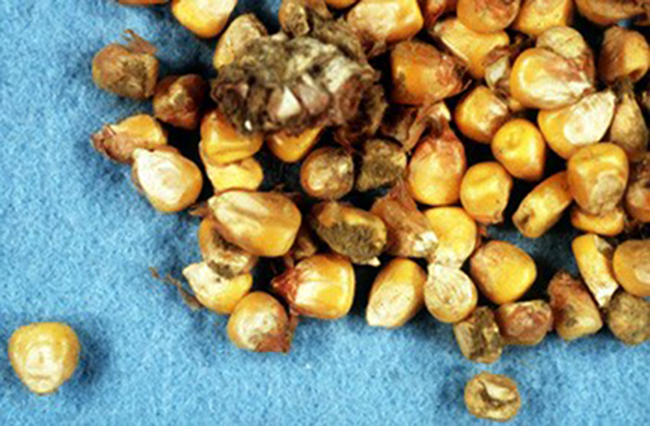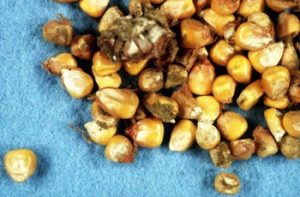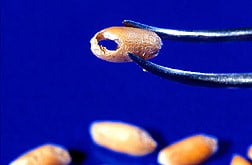PREVENTION OF POULTRY FEED SPOILAGE DURING STORAGE

Dr. DEV KUMAR, Dr. K.KARUPPASAMY, Dr. SHAITAN SINGH MVSc Scholars (POULTRY SCIENCE) CENTRAL AVIAN RESEARCH INSTITUTE, Izatnagar-243122 
Harvesting of crop is seasonal, but consumption of food grain is continuous. The market value of the produce is generally low at harvesting time. So the grower needs storage facility to hold a portion of produced grain to meet the requirements in addition to selling surplus produce when the marketing price is favourable.
Traders and Co-operatives at market centres need storage structures to hold grains when the transport facility is inadequate. The government also needs storage structures to maintain buffer reserves to offset the effects produced by the vagaries of nature. Hence, there is necessity to store the produce for different periods primarily for commercial reasons. However, during storage considerable damage in poultry can be caused by moulds and insect infestations. Insects are present in most grain-handling systems and it is almost impossible to eliminate them completely. Control of moulds and insect is very much important to prevent poultry feed spoilage during storage. 
REQUIREMENTS FOR IDEAL STORAGE FACILITY
- It should provide maximum possible protection from ground moisture, rains, insect pests, moulds, rodents, birds, fire, etc.
- It should provide the necessary facility for inspection, disinfection, loading, unloading, cleaning and reconditioning.
- It should protect grain from excessive moisture and temperature favourable to both insect and mould development.
- It should be economical and suitable for a particular situation.
- HOW TO MINIMISE MOULDS AND INSECTS?
Damage from moulds can be prevented by proper drying and aeration of the grain. However, considerable damage can also be caused by insect infestations which can occur in dry grain. Insects are present in most grain-handling systems and it is almost impossible to eliminate them completely. However, loss from insect damage can be kept to a minimum by using the following program: 1. Remove all dust and old grain from bin walls, ceilings, floor and aeration ducts before refilling the bin. 2. Repair cracks from where insects might enter. 3. Spray inside the bin with a residual insecticide at least one a week before storing new grain. 4. Never store new grain on top of old since insects will move from the old grain into the new. 5. Cool grain as quickly as possible. Insects cannot reproduce at temperatures below 18°C. 6. Check stored grain regularly to detect hot spots. 7. Fumigate difficult insect infestations.
PREVENTING INSECT PROBLEMS IN STORED GRAIN
- Clean in and around the storage facilities. Grain storage facilities, and the area around storage facilities, should be cleaned thoroughly prior to storing grain.
-
Clean equipment used to move grain. Grain left in equipment throughout the summer months can result in new grain being placed into storage becoming infested. Combines, truck beds, grain wagons, augers and other equipment used to move grain should be cleaned before moving the grain. Other potential sources of grain infesting insects include livestock feeds, old seed bags, spilled grain, etc.
- Inspect grain storage facilities for signs of deterioration, especially for leaks or holes through which insects or rodents can gain access to the stored grain.
-
Treating storage facilities. Depending on the commodity to be stored, storage facilities may additionally be sprayed or dusted, if needed, with a recommended insecticide before storing grain in the bin (e.g. malathion, diatomaceous earth or cyfluthrin
– refer to product labels for details). Note – some commodities, such as canola, flax and sunflowers, should not be stored in facilities recently treated with malathion.
- Dry and Cool Grain.
If possible, grain should be dry before being put into storage, and cooled as quickly as possible. For long-term storage, lower the grain temperature below 15°C as soon as possible after the grain is placed in storage. At 15°C the stored product insects stop laying eggs and development stops. Aeration systems used during the night immediately after harvest should have the grain below 15°C in about 2 weeks. Once the grain mass is cooled to the desired temperature, fans should be sealed to prevent unwanted air migration through the mass that could result in early grain mass warm-up. Cold grain has a longer storage life than warm grain.
- Monitoring Pest Levels.
Stored grain insects can be monitored either with traps, or by taking grain samples with a bin probe and then visually inspecting the samples. Traps for stored grain insects are long cigar-shaped tubes that are stuck into the top of the grain sample. For some traps there are pheromone attractants available, which may improve trapping-efficiency. Regular inspection with traps or probe samples will indicate potential problems that may be developing in the bin.
CONTROL OF FUNGUS FEEDING INSECTS Be sure the grain is in good storage condition by:
- removing crusted areas and hot spots
- burning or burying discarded grain
- drying grain, if necessary
Chemical control of fungus-feeding pests is not necessary, since they cannot survive in sound, dry grain.
CONTROL OF GRAIN-FEEDING INSECTS
Grain-feeding insects are treated differently from fungus-feeding insects
. There are 4 main options for controlling insects feeding on stored grain.
Cold Temperatures
An effective method of controlling insect infestations in stored grain in winter is to lower the temperature of the grain. Rusty grain beetles and most other stored grain insects can be killed by periods of low temperatures as follows:
| Grain Temperature in degrees Celsius | Time Required to kill insects |
| -50 C | 12 weeks |
| -10 0C | 8 weeks |
| -150 C | 4 weeks |
| -20 0C | 1 week |
Grain in bins over 6 metres in diameter will not cool sufficiently without assistance, such as through aeration, to control some insects.
- High Temperatures
All four stages of insects (eggs, larvae, pupae and adults) will die if subjected to high temperatures for a sufficient period of time. The most realistic use of high temperatures for controlling insects would be when the grain was tough and in need of drying. In this case, the insects would be killed at the same time as the grain is dried. The insects need to be exposed to temperatures in the range of 50 to 55˚C for approximately 15 minutes. 3. Moving Grain The use of pneumatic conveyors to move grain has been shown to give good control of some insect pests of stored grain.
- Insecticides
Chemical treatment of the bin is another option. Diatomaceous earth can be used for control of grain feeding insects in many stored grains. It is sold under the trade names Protect-It or Insecto. Fumigants containing aluminium phosphide, such as Phostoxin, are available in pellet or tablet form. These fumigants should be used only when the grain temperature is above 4oC. The use and sale of aluminium phosphide in Manitoba is restricted to licensed pesticide applicators possessing a valid stored agricultural products license.
References
-
Bottomley, R.A., M.C. Christensen, and W.F. Geddes. 1950. “Grain Storage Studies IX – The Influence of Various Temperatures, Humidities and Oxygen Concentration on Mould Growth and Biochemical Changes on Stored Yellow Corn,” Cereal Chemistry, 27: 271.
-
Boxall, R.A., M. Greeley, and D.S. Tyagi. 1979. “The Prevention of Farm Level Food Grain Storage Losses in India – A Social Cost Benefit Analysis,” The Bulletin of Tropical Stored Products Centre, 37: 11.
-
Daniel, V.A., P. Rajan, K.V. Sanjeevarayappa, K.S. Srinivasan, and M. Swaminathan. 1977. “Effect of Insect Infestation on the Chemical Composition and the Protein Efficiency Ratio of Proteins of Bengalgram and Redgram,” Indian Journal of Nutrition and Dietetics, 14: 70.
-
Glass, R.L., J.G. Ponte, C.M. Christensen, and W.F. Geddes. 1959. “Grain Storage Studies XXVIII – The Influence of Temperature and Moisture Level on the Behaviour of Wheat Stored in Air or Nitrogen,” Cereal Chemistry, 36: 341.





Hi to every single one, it’s truly a pleasant
for me to go to see this website, it consists of precious Information.